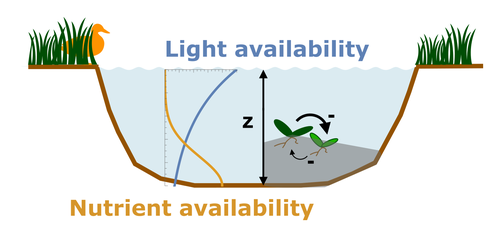
How to evolve an alternative stable state
 based on reviews by Jean-François Arnoldi and 1 anonymous reviewer
based on reviews by Jean-François Arnoldi and 1 anonymous reviewer

Evolutionary emergence of alternative stable states in shallow lakes
Abstract
Recommendation: posted 31 May 2022, validated 03 June 2022
Coulson, T. (2022) How to evolve an alternative stable state. Peer Community in Ecology, 100100. https://doi.org/10.24072/pci.ecology.100100
Recommendation
Alternative stable states describe ecosystems that can persist in more than one configuration. An ecosystem can shift between stable states following some form of perturbation. There has been much work on predicting when ecosystems will shift between stable states, but less work on why some ecosystems are able to exist in alternative stable states in the first place. The paper by Ardichvili, Loeuille, and Dakos (2022) addresses this question using a simple model of a shallow lake. Their model is based on a trade-off between access to light and nutrient availability in the water column, two essential resources for the macrophytes they model. They then identify conditions when the ancestral macrophyte will diversify resulting in macrophyte species living at new depths within the lake. The authors find a range of conditions where alternative stable states can evolve, but the range is narrow. Nonetheless, their model suggests that for alternative stable states to exist, one requirement is for there to be asymmetric competition between competing species, with one species being a better competitor on one limiting resource, with the other being a better competitor on a second limiting resource.
These results are interesting and add to growing literature on how asymmetric competition can aid species coexistence. Asymmetric competition may be widespread in nature, with closely related species often being superior competitors on different resources. Incorporating asymmetric competition, and its evolution, into models does complicate theoretical investigations, but Ardichvili, Loeuille, and Dakos’ paper elegantly shows how substantial progress can be made with a model that is still (relatively) simple.
References
Ardichvili A, Loeuille N, Dakos V (2022) Evolutionary emergence of alternative stable states in shallow lakes. bioRxiv, 2022.02.23.481597, ver. 3 peer-reviewed and recommended by Peer Community in Ecology. https://doi.org/10.1101/2022.02.23.481597
The recommender in charge of the evaluation of the article and the reviewers declared that they have no conflict of interest (as defined in the code of conduct of PCI) with the authors or with the content of the article. The authors declared that they comply with the PCI rule of having no financial conflicts of interest in relation to the content of the article.
no declaration
Evaluation round #1
DOI or URL of the preprint: https://doi.org/10.1101/2022.02.23.481597
Version of the preprint: 1
Author's Reply, 26 May 2022
Decision by Tim Coulson , posted 23 Apr 2022
, posted 23 Apr 2022
Reviewed by anonymous reviewer 1, 09 Apr 2022
Reviewed by Jean-François Arnoldi, 22 Apr 2022
Ardichvili, Loeuille and Dakos propose a modelling study of the evolution of macrophyte living-depth in shallow lakes. They look for the condition that lead to potential regime shifts, where a strategy may suddenly dominates, if nutrient enrichement varies.
This is seen as an example of a more general endeavour: to investigate the evolutionnary underpinnings of ecological regime shifts.
The authors find that the modelling scenarios and parameters that lead to potential regime shifts are strictly nested within those that allow for sympatric diversification, and that the potentality of regime shifts may change along the course of evolution. It should be noted that in the context considered, diversification is a prerequisite for regime shifts, since the latter require at least too competing strategies to coexist prior to the shift (see question 2-3 below). What is not obvious is that conditions leading to diversification can also allow for regime shifts. I suppose that it could have been the case that the two constraints would be mutually exclusive (but see question 1 below).
##########
I read the manuscript in depth and found it to be well conducted, with clear figures and rigourous numerical analysis of the model. I am confident that the reported findings are correct.
I do not have much to ask from the authors, the manuscript is probably publishable as is, but below I try to be a bit more critical in hope to help the authors improve the manuscript. Indeed, I think that some work is needed to make the message appealing to a wider audience than theoreticians interested in adaptive dynamics or regime shifts models.
##########
My major issue is that I have difficulties extracting a clear message that may be relevant beyond the specific modelling context considered. Because of that, I end up with many questions instead of a clear picture.
Questions:
1/Is it a coincidence that regime shifts and diversification emmerge from similar mechanisms?
2/Are the strategies that coexist and allow for regime shifts ressemble those found in shallow lakes? From the discussion I understood that this was not the case.
3/Is it really necessary to have sympatric speciation in order to find regime shifts of this kind in nature? Isn't it enough for populations to exhibit some placiticity or enough intraspecific phenotypic variation?
4/Since we are considering eco-evolutionnary interplays, why not go one step further and allow strategies to evolve in reponse to nutrient enrichment?
##########
Suggestions:
A/The paper is very descriptive and quite long, I would suggest trying to make it more concise and focus on a clear message, simple and general enough to have a chance to be relevant in natural systems.
B/It would be good to first recall the scenarios and parameters that lead to regime shifts in the ecological model, so that we can see more clearly how constraining it is to ask for those conditions to be evolutionnary stable.
Minor:
Fig.5 second line, please recall (e.g as a vertical line) the value N0 at which the evolution took place (5 mg/m2 according to the table), so that we see the reference point from which the ecosystem is perturbed.
###########
https://doi.org/10.24072/pci.ecology.100413.rev12









